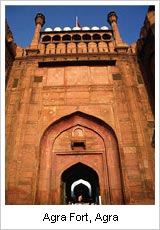| Chini
Ka Rauza (Agra) |
 Introduction: Introduction:
Mulla Shukrullah Shirazi was the Prime Minister of Mughal
emperor Shah Jehah and also a famous poet. He composed poetry
under the pseudonym of 'Allami'. He took fancy to building
his own mausoleum in 1639 with elaborate ornamentation. He
chose glazed tiles as his medium to create the masterpiece
that would enshrine his tomb forever. Every portion of this
unique monument is profusely adorned with bright color schemes,
known as 'Chini ka Rauza'. Chini ka Rauza is a classic example
of the Persian influence on Mughal architecture of that period.
The tomb was constructed in 1635. Originally high walls enclosed
this entire building complex, and there were gateways in North
and South direction, along with two multistoried towers but
now only the main Tomb building has survived.
The tomb of Allama Afzal Khan, Chini ka Rauza, derives its
name from the colorful tiles (chini) that cover the walls
of the tomb. The blue, green and yellow tiles that embellish
this medieval Indian mausoleum constitute its most remarkable
feature. In fact this glazed tile decoration dominates the
entire architectural composition of this building.
Other prominent features of this building include presence
of an Afghan-style bulbous dome, and beautiful decoration
with geometric and floral arabesque in multi-colored glazed
tiles. Despite the dilapidated condition of the building,
the unique glazed-tile decoration of the building is worth
watching.
The main tomb is square in plan with 79 feet (8.48m) side.
The central chamber is in octagonal plan having diameter of
27'10" (8.48m), with eight arched recesses. Out of these
eight arched recesses, four are pentagonal arched which are
close and rest of the four are square which provides openings
on all four sides. There are four square chambers, one at
every corner, which are inter connected with the side halls
or porches on all four sides.
The upper part of the tomb contains an arched passage which
is three feet (94 cm) wide and opens on all the four corners
into four rooms just above the lower corner chambers and gives
a double storeyed effect to the tomb building. This passage
was accessible by a stairway on the southern side which ultimately
leads to terrace. The superstructure of the building includes
a shallow dome which is crowned by inverted lotus and kalash
finial, and pinnacles on all the four corners. |
|
|
|
 |
All rights
Reserved. Best Viewed at 1024 x 768 using Netscape or Internet
Explorer version 5.0 or above.
Copyright ©2006-2007 CR License, LLC. All Right Reserved.
Terms of Use | Privacy Policy | Travel Agents |
|
|

